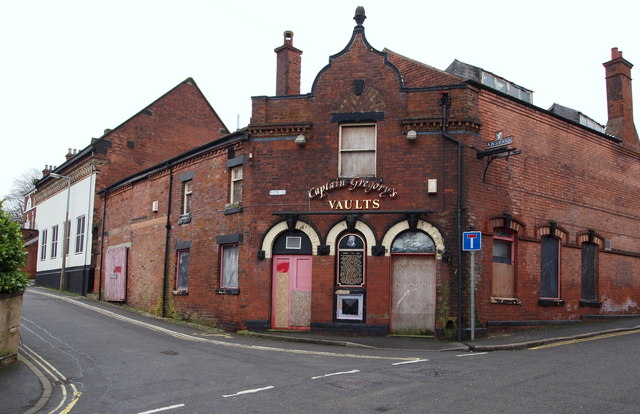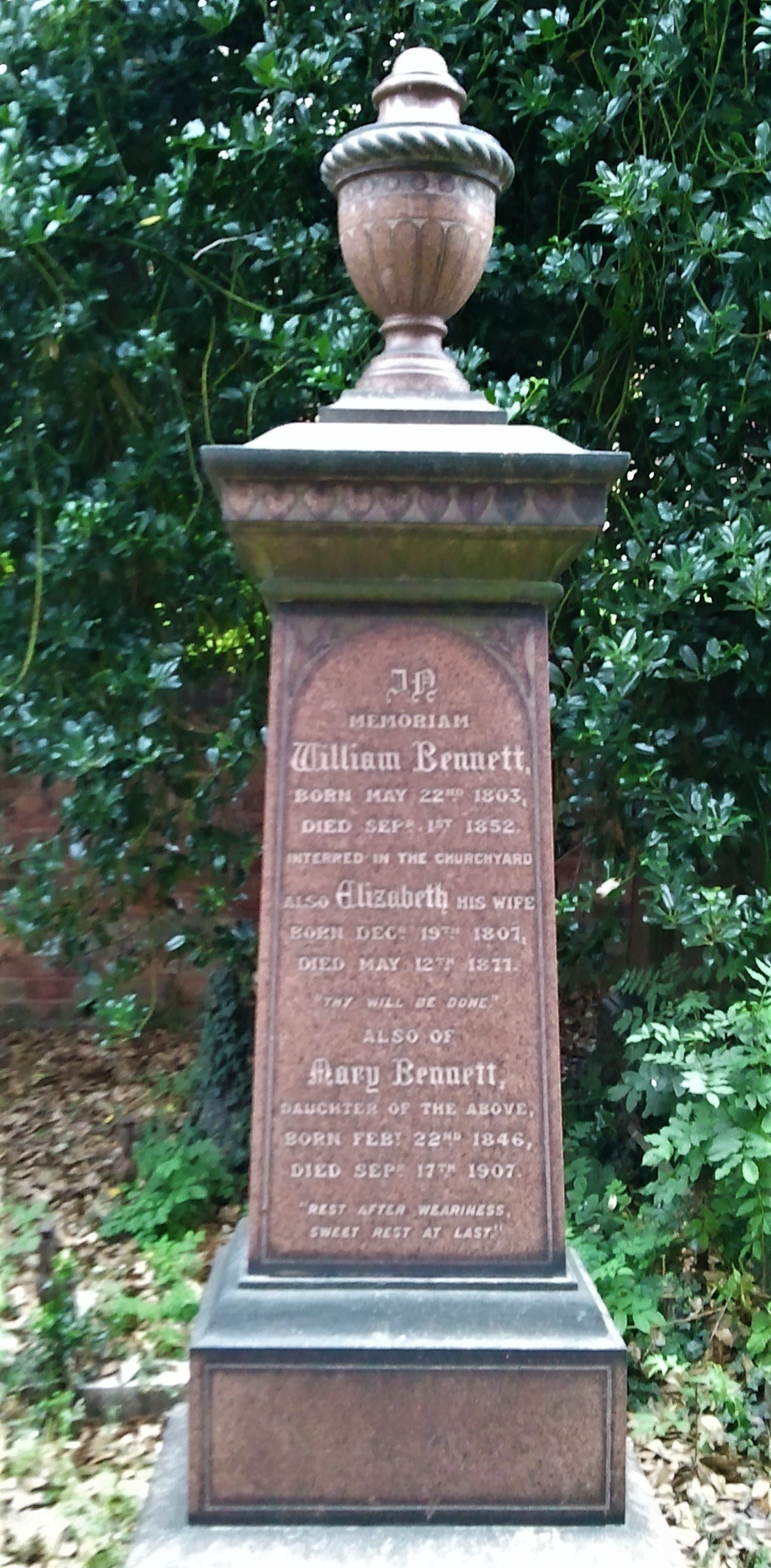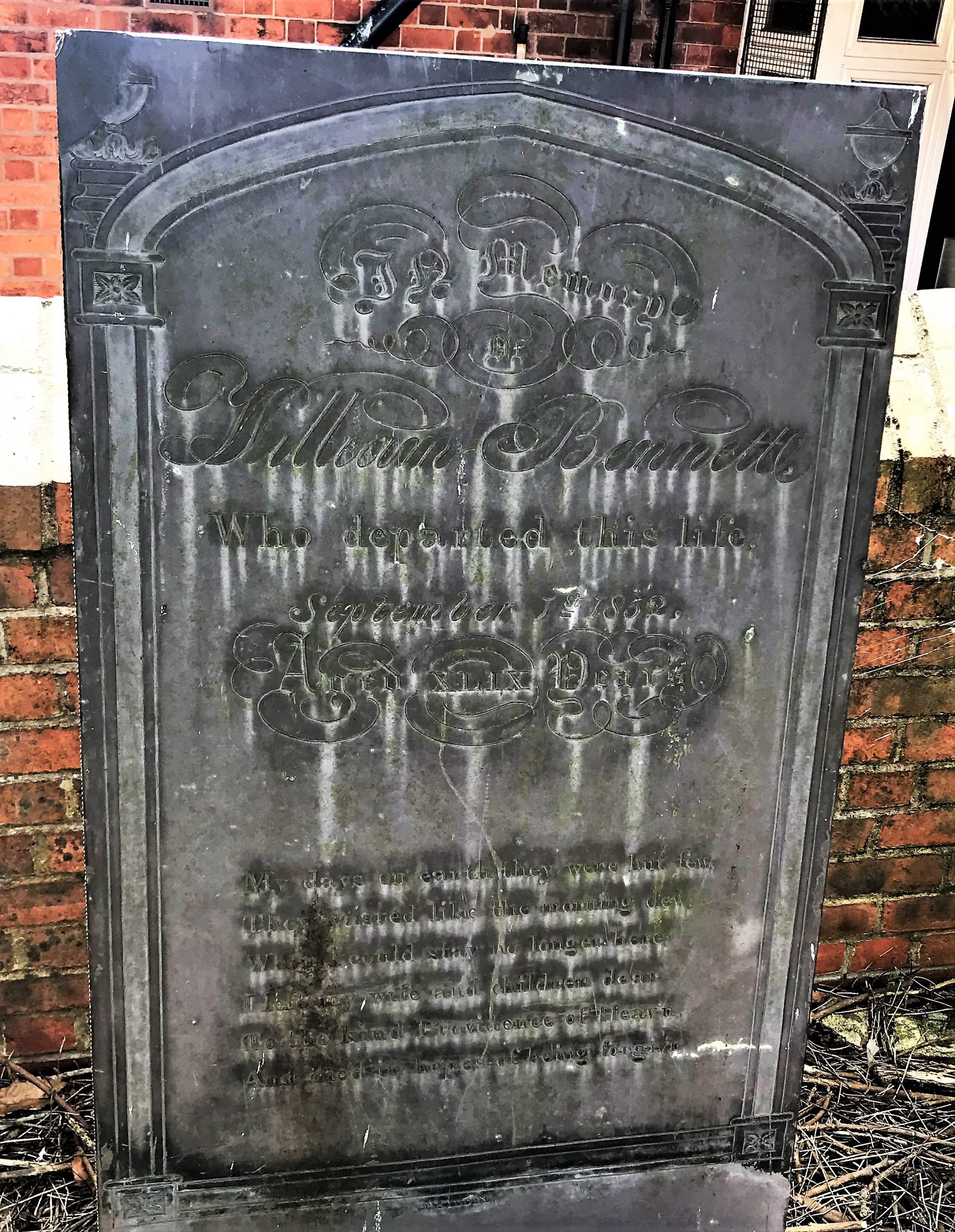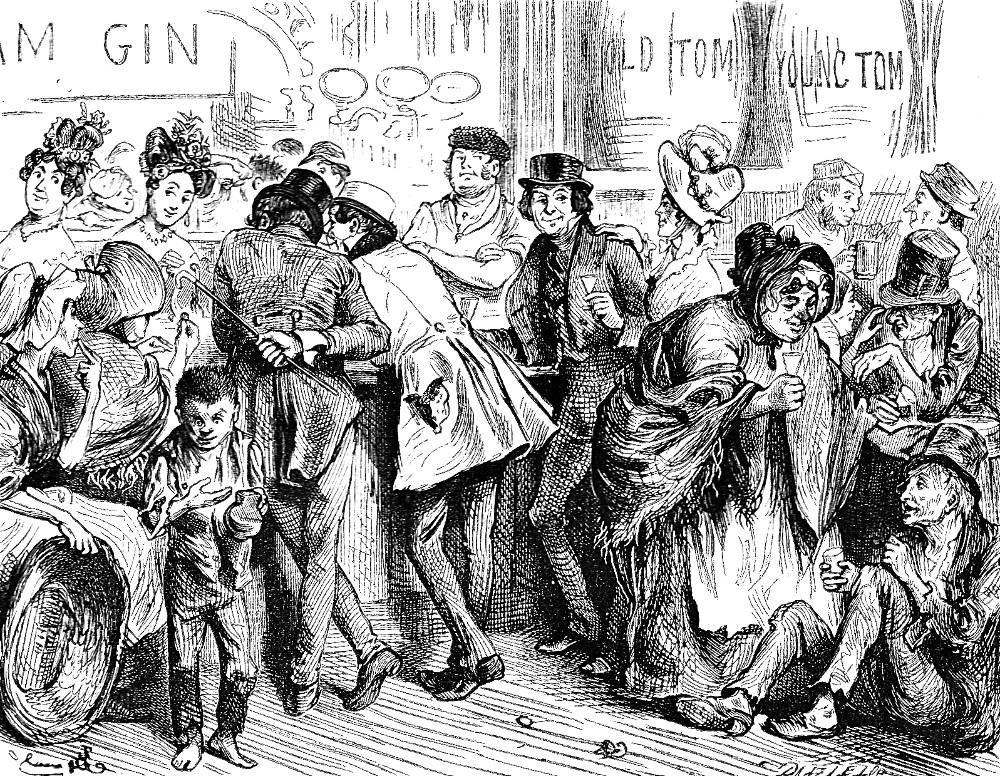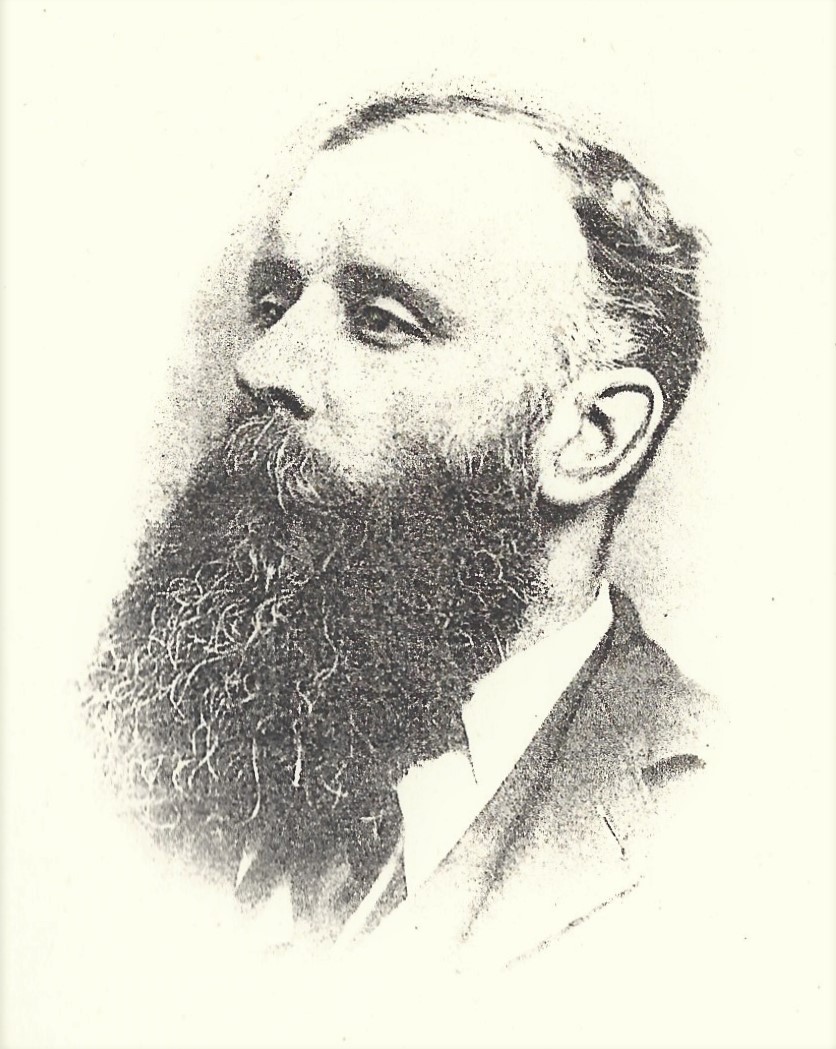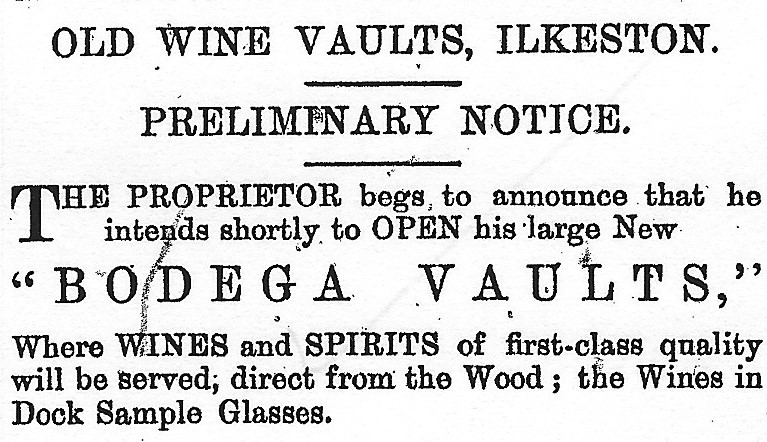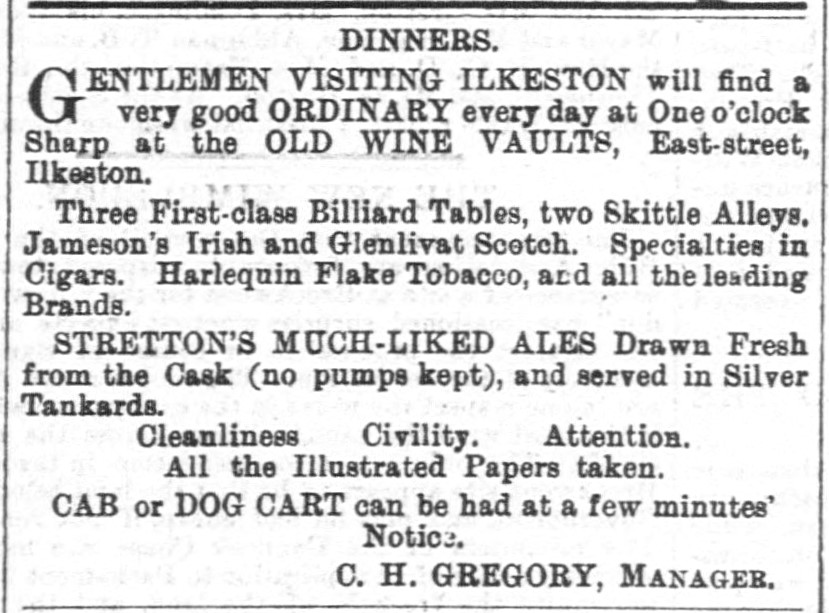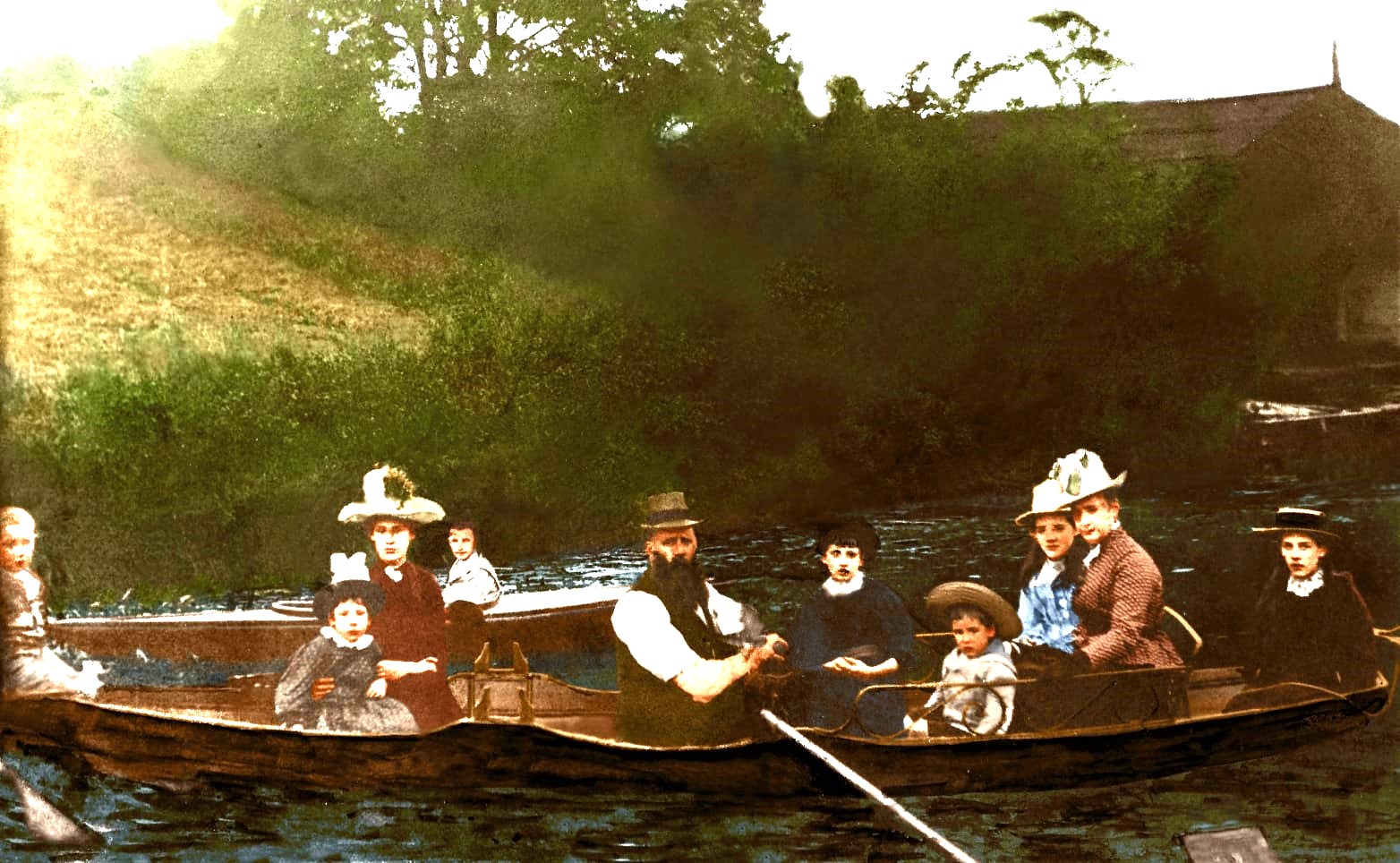Crossing over at the end of East Street, we now go back to its junction with Bath Street.
Adeline points out that “on the South side of East Street was Mr. George Bunting‘s pork shop. This was the only shop on that side. (house 13 on the East Street map)
Past Bunting’s pork shop and Dr. Murray’s yard, were two old houses.
—————————————————————————————————————–
The Bartlams
Adeline remembers that “Mr. Bartlam worked a stocking frame at home”, at number 17 East Street (in the 1871 and 1881 censuses) … house 14 on the map
By 1891 it had been renumbered as 52 East Street.
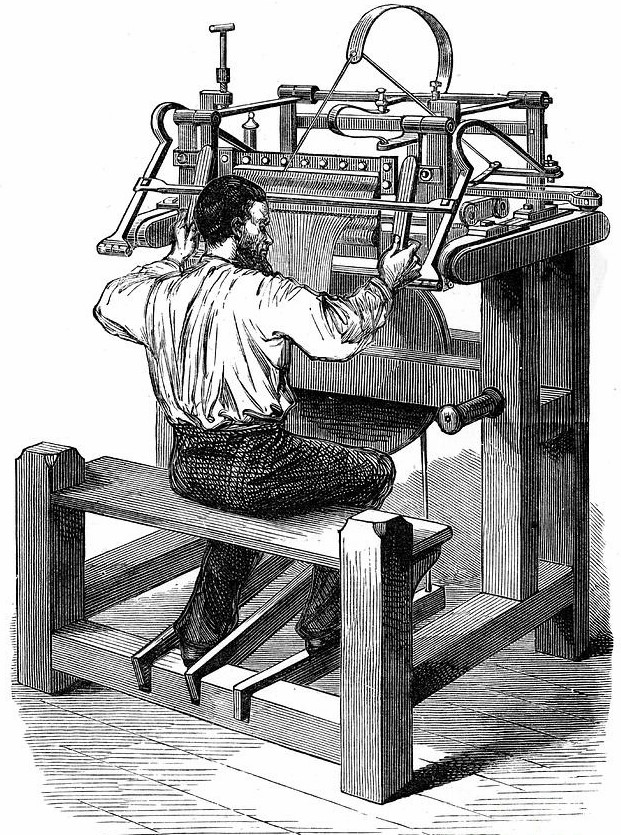
Thomas Bartlam, framework knitter, and Ann Huskinson, straw bonnet maker, married on February 12th, 1854, and then lived in East Street until the end of the century.
Their eldest son, George Huskinson Bartlam, was born on March 4th 1854 but his name was mistakenly recorded as Thomas Huskinson Bartlam. It was only after 70 years that this mistake was corrected in the records (on November 8th 1923).
Another son was Thomas junior, born on October 12th 1855 and correctly named as Thomas !! He married Eliza Grimley in 1884 — his bride was one of the Grimleys of Club Row, being the illegitimate daughter of Ellen Grimley and thus the grand-daughter of John and Mirah (nee Tueman). Ten years after the marriage and with three children, the couple were not happy. In March 1895 Eliza charged Thomas with physical abuse, and not for the first time. She demanded, and was granted, a separation order. Thomas was also fined heavily for the assault but chose instead, the alternative — 21 days in jail. Ominously however, custody of the children was granted to Thomas — the magistrates were aware that Eliza’s mothering instincts left much to be desired. The father was to pay his wife 4s per week.
The wider Bartlam family continued to occupy this house into the next century and Ann died there, at (then) 52 East Street, in 1901, aged 75.
—————————————————————————————————————————————————
Then Adeline remembers that “a spinster lived in the second house”. (not sure .. this could be 15, 16, 17 on the map ?)
Gap alert!!
The spinster is difficult to identify. She may be Elizabeth Hall, spinster, of Shoreditch, London, who appears at 16 East Street on the 1871 census.
—————————————————————————————————————————————————
The Wine Vaults…..
The Old Wine Vaults (closed ot patrons), photo taken by David Hallam-Jones
Looking at the photo above, Adeline is taking us down East Street (on the right) to its junction with High Street (on the left). At the end of High Street is the white building which was once the Unitarian Chapel, and beyond that is Dalby House, now the home of the Erewash Museum.
Adeline points out that “On the South side of East Street, was the Wine Vaults”. (premises 20 on the map)
On the 1871 and 1881 censuses this was 15 East Street; by 1891 it had been ‘renumbered’ and was next to number 51 East Street, though without a number itself .. was it number 50 ? It remained like this into the next century.
Despite the national election victory of the Liberals in 1868, the Pioneer noted that only two ‘Yellow houses’ remained in Ilkeston… the Wine Vaults and the Prince of Wales in Bath Street.
But this did not stop the ‘Yellow voters’ from supping in the ‘Blue houses’, probably under the impression that he ‘only is a jolly good fellow who can sup of the ‘Blue’ as well as the ‘Yellow’.
‘Tilkestune’ recalled that, when voting at the national election, his father “had gone up some steps and into a room where, his credentials as a voter being admitted, he was asked who he wished to vote for, and having told the small company of men who were conducting the election, the number one was put against his two candidates, and so from minute to minute and from hour to hour throughout the day the state of the poll was known”.
By the next election in 1874 the number of ‘Yellow houses’ in Ilkeston had risen to about 12.
In that election the Ilkeston Telegraph calculated that in Ilkeston 188 people had voted Conservative (the Blues) and 150 had supported the Liberals (the Yellows). However results from the surrounding villages, centres of a modified feudalism, added to the local influence of the Duke of Rutland and of the colliery proprietors — all but one of whom were “Blue” – and would ensure that “Ilkeston is likely to retain its unenviable notoriety as a tory stronghold”.
As you will gather the Telegraph was a ‘Liberal’ newspaper!
Also before this election the Ballot Act (1872) had been passed by William Gladstone’s Liberal Government.
This introduced the secret ballot into elections to stop bribery, intimidation and corruption, practices which did decline as a consequence of the Act, but were not eradicated.
At the time of the Act’s passing, the House of Lords had the “not un-English objection to secret voting” but while passing the Bill “in order to gratify a popular craving, it took no pains to conceal its repugnance to, and its dignified abhorrence of, the idea of departing from the time-honoured method of open and fearless recording of votes”. (IP May 1880).
Because of this feeling in the Lords, a Limitation Clause was inserted into the Act — the ‘new-fangled device’ of a secret ballot would thus be tried and tested for eight years at the end of which period the Act might be altered or repealed.
The Expiring Laws Continuance Bill of 1880 included the renewal of the Ballot Act.
The secret ballot has been with us ever since.
The Bennetts at the Vaults.
“Mr. and Mrs. Bennett and their two daughters lived here. Mr. Bennett died after a short illness, and Mrs. Bennett became landlady”.
Mrs Bennett was born Elizabeth Smith in Bilborough on December 19th, 1807, the daughter of victualler Samuel and Sarah (nee Dalley).
On May 23rd, 1850 the Nottinghamshire Guardian reported that …
the members of the Earl Grey Lodge of the M’U’ assembled at the lodge rooms, **Elizabeth Smith’s, wine vaults, Ilkeston on Whitsun Tuesday for the purpose of attending divine service at Church.
After an impressive sermon by the Rev. G.S. Ebsworth, they returned, and 150 brothers partook of an excellent dinner under an awning, which was served up in first-rate order, P.G. Duro presided.
The Cotmanhay brass band attended, and enlivened the festive scene with a variety of martial and popular airs. Songs, toasts, and sentiments of a social, moral, and fraternic, and national character were given and received with true patriotic and fraternal feeling.
The day was passed with joyous hilarity.
**the ‘Elizabeth Smith’ referred to here was probably Elizabeth Bennett.
Elizabeth’s father Samuel was the landlord at the ‘spirit vaults‘ in 1852 when ‘he dropped down dead about 7 o’clock on Monday morning (May 10th), as he was proceeding to open the shutters’. (NG May 1852).
The Derbyshire Advertiser and Journal told a different story; Samuel was on his way to feed his fowls and pigs at the rear of the premises when he fell down and died instantly.
They agreed that Samuel was aged 78.
At the inquest into the death, surgeon Robert Murray — who at that time lived in Bath Street, at its corner with Mount Street, and who had examined Samuel — decreed death was due to spasms of the heart.
Daughter Elizabeth married lacemaker and victualler William Bennett on January 3rd, 1844. The groom was the son of William Bennett senior and his first wife, Elizabeth (nee Child)
Along with Thomas Jennison of Belper, William Bennett was appointed as High Bailiff of the Derbyshire County Court whose role it was to enforce payment of ‘small debts’ — those not exceeding £20.
Eight years and two children later William also died at the Wine Vaults, aged 49 — four months after the death of Elizabeth’s father.
Elizabeth, ‘a prim and matronly lady’, took over as proprietor of the Inn and eventually retired from the Wine Vaults at the end of 1873.
Her eldest daughter, Lizzie, married Mr. Francis Sudbury, who became first Mayor of Ilkeston.
The young couple’s first home was in the house at the corner of East Street, and the Market Place.
Later Mrs. Bennett bought a plot of land on the east side of Market Street, and built two houses on it.
Mr. and Mrs. John Childs, who had retired from business, lived in the one nearest the Cricket Ground.
Mr. and Mrs. F. Sudbury and family left the Market Place house, and lived in the second one.
Elder daughter Elizabeth married Francis Sudbury, later the first mayor of Ilkeston, in April 1866.
When Mrs. Bennett retired from the ‘Wine Vaults’, she and her daughter Mary lived in Market Street, and after Mrs. Bennett’s death, Mary went to live with her sister, Mrs. F. Sudbury, who then resided at Field House.
The other daughter was Mary who remained unmarried, living with her sister Elizabeth when their mother died in Market Street in May 1877.
Below, William Bennett’s memorial erected in Stanton Road Cemetery, probably in 1877, at the time of his wife’s death, and 25 years after his own. As the column states, William is buried in the churchyard……
…. in the churchyard, where his marker stands against the south wall
In memory of William Bennett who departed this life September 1st 1852 aged XLIX years.
My days on earth were but few,
They wasted like the morning dew,
When I could stay no longer here,
I left my wife and children dear
To the kind providence of Heav’n,
And died in hopes of being forgiven.
Charles Hiram Gregory.
In December 1873 Charles Hiram Gregory, late of Liverpool, became landlord of the Wine Vaults when the licence was transferred from Elizabeth Bennett. He was the son of Ilkeston-born lacemaker, later publican, Charles (who acquired the licence from Elizabeth Bennett) and Heanor-born Tamar (nee Bircumshaw) and was a first cousin to Bath Street grocer Isaac Gregory.
His wife was Emma Jane Jackson of Liverpool, daughter of Captain James Jackson of the Mercantile Marine.
Charles Hiram’s father, mother and younger brother Herbert left Nottingham, where they were living, to arrive at the Wine Vaults in the 1870’s.
A busy night at the Spirit Vaults in the 1870s (inspired by Charles Dickens’ “Scenes” and “Sketches” by Boz)
Charles Gregory senior died at the Wine Vaults on November 15th, 1877, aged 69; the inn’s licence then passed to his widow.
By 1881 Tamar was at the Wine Vaults with her son Charles Hiram and his family, while Herbert was manager of the Old Harrow Inn in the Market Place. Charles Hiram also owned that inn.
At one time the following notes appeared attached to the exterior corner wall of the Wine Vaults Inn.
“Born in Nottingham on February 25th 1841, Charles Gregory went to sea as an apprentice at the age of 17 and for the next 16 years worked aboard merchantmen trading to India, China and America. So rapidly was he promoted that at the age of 28 he was entrusted with the command of a large East Indiaman, the ‘Naturalist’. Captain Gregory had several narrow escapes from being shipwrecked and proved to be a great leader of men on numerous occasions. On one such occasion, when his ship met with a heavy cyclone, the vessel was virtually dismantled; so terrible was the situation that all those on board were up to the middle in water and Captain Gregory, during the whole of one night, was engaged in reading the Bible to the sailors, expecting the ship would go down any moment. However to their joy and surprise the vessel kept afloat and eventually landed at Calcutta. He was married in New York in 1872, to Emma Jane, came to Ilkeston, and took over the Old Wine Vaults in November 1873, and served on the Local Board and was treasurer of the Freemasons’ Lodge for 4 years, having been connected with the Order for 12 years, a truly remarkable man”. (A similar, slightly more detailed description appears in Trueman 1)
A game of billiards anyone??
“The Captain, with his military swagger and patriarchal beard, was a very attractive personality, especially to the sporting element of the younger generation of Ilkestonians, with which the billiard saloon of the ‘Wine Vaults’ was a very popular resort”. (RBH)
The Billiard Saloon was opened in June 1879, when an exhibition match was played by Messrs. Roberts, the champion and ex-champion – father and son John Roberts senior and junior? – when a game of ‘1000 up’ (first to score 1000) was followed by seven games of pyramids. (This was a game where 15 red balls were arranged in a triangle and players took turns to try to pot them with the white).
The saloon had three ‘first-class’ tables and was capable of seating 200 spectators.
In the following month Captain Gregory was offering for sale a full sized billiard table, by Burroughs & Watts — in thorough good condition!! No wonder!!
About the same time he was announcing the imminent opening of his new Bodega Vaults – serving wines and spirits of first-class quality, direct from the wood, in Dock Sample Glasses – and in August of 1879 he opened a Bagatelle Room at the Inn.
Three months later he resigned his position as member of the Local Board – pressures of work !!
In February 1881 a large crowd was attracted to the Vaults to see Nottingham’s own William Custance take on the Leed’s champion Nathan Jones in a billiards match of 500 up, and the best of seven games of pyramids.
But it was no match — Custance ran out an easy victor.
In September of the same year police sergeant William Colton entered the Vaults close to midnight and found a group of four customers in the billiard room trying to pot a few balls.
The friendly arm of the law chivvied them on; “Come, it is time you were out; it is nearer twelve than eleven”.
The men said that they were not playing for money and had been given permission by Captain Gregory to play a half game of billiards before he had left them to go to his other pub, the nearby Harrow Inn. And so they played on.
The friendly arm of the law now turned less friendly and just over three weeks later Charles Hiram was appearing at the Petty Sessions, charged with keeping his house open after hours.
At court he stated that he had always tried to keep an orderly house and operate within the law. Only once before had he been cautioned for a similar offence. The police endorsed what the landlord had said and the magistrates were thus inclined to dismiss the case, with a warning, for which Charles Hiram was unctuously grateful.
As for the ball-potters, only William Richard Lawson, manager at Scales and Salter’s (boot and shoemakers of Bath Street), was fined. Jonathan Pursglove and George Castello alias ‘The Major’ were paid servants of the landlord, employed as billiard markers and so had a right to be on the premises. The same right was granted to Edmund Tatham, a bone fide traveller who was ‘sleeping in the house’ at the time.
Post script: Six months later and ‘The Major’ was dead.
Once a druggists’ assistant in the town he had been recently scraping a living as a billiard marker. Ill for some time, walking only with the aid of a stick, he was lodging in Pimlico.
And there he was found by two policeman, lying on the ground ‘in a dying state’. He survived until the next morning.
The Advertiser presumed that his death was accelerated by ‘too scanty a subsistence’.
Jonathan Pursglove lasted many more years. He died on September 18th 1896, aged48, after eating poisoned mushrooms.
For sale.
When up for sale in 1882 the Old Wine Vaults was described thus:
‘an old-established, well-accustomed and commodious public house… containing billiard-room 80 feet by 17½ feet, with 3 full-sized tables; Music Hall, 53 feet by 15 feet; a large corner Wine and Spirit Vaults, with Cottage attached for manager; principal Wine and Spirit Vaults, Front Parlour, Office, private Bar, large Tap-room, Dining-room, Kitchen, and extensive Cellars, 5 Bedrooms, and a Club-room, 35 feet by 16 feet, with Committee-room attached. The Outbuildings comprise a 2-stall stable and coach-house, with hay loft over, pigsties, cottage, etc….. The buildings are for the most part nearly new. The wine vaults, billiard-room, and music hall are heated with hot water. The goodwill of the trade, which is very extensive and valuable, will pass with the Freehold.’
Herbert Gregory had married Sarah Ann Chambers, the daughter of Nottingham twist hand John and Ann (nee Cassaday) in 1870, and then lived with his parents in Nottingham before arriving in Ilkeston. His wife however had much preferred to stay in the Nottingham rather than ‘burying herself in Ilkeston’. The ‘big city’ offered her an attraction in the shape of Herbert Thrutchley with whom Sarah Ann had formed an attachment.
When husband Herbert became manager of the Wine Vaults in East Street in 1881 he gave his wife an allowance of 5s a week so that, with her wage of 10s from her employment at a Nottingham warehouse, she could remain in the city. Subsequently he learned of his wife’s adultery and petitioned for a divorce which was granted to him in May 1886.
Herbert died at the Wine Vaults in January 1888, while serving as the manager there.
—————————————————————————————————————————————
from the Derby Mercury (November 1888)
———————————————————————————————————————————
On February 18th, 1892, Tamar Gregory died and the licence was transferred to her son Charles Hiram.
On June 17th, 1892 and boasting of 19 years as landlord of the Wine Vaults, Charles Hiram ‘opened’ the rejuvinated Ray’s Arms Hotel on Ray Street, Heanor — with its own bottle department, two splendid billiard tables, and selling Gregory’s Champion 2d Cigars and his Home-made Chutney. The Captain, an ‘old collier’ himself, was especially welcoming of Heanor colliers and cyclists, who would receive ‘special attention and accommodation’.
Charles Hiram had taken over the license for the Heanor Inn from Edward Batty, and as a result, in June 1892 he gave up the license for the Wine Vaults to Richard Greaves.
In December 1893 Charles Hiram became landlord at the Erewash Hotel in Langley Mill but that tenure didn’t last long — in July of the following year Charles Hiram was back at the Wine Vaults, replacing Richard Greaves.
On May 12th 1898 the licence was transferred from Charles Hiram to “F. Stokes” and on June 28th 1898 it was back in the hands of Charles Hiram !
Charles Hiram on the water once more … courtesy of his great grand daughter Claire Gregory
———————————————————————————————————————————-
The Ilkeston Female Friendly Club
August 3rd 1894 … , after its meeting at the Unitarian schoolroom in High Street, the Club held its tea and dance at the large hall at the Wine Vaults, kindly lent by Captain Gregory. At that time there were 83 members on the books … each paid 1s per month in contribution, and members were entitled to 6s per week for 13 weeks as sick pay, and 3s per week for 26 weeks after the first quarter. At the death of a member £4 was allowed.
It certainly made a change from Miners’ meetings which were so frequently held there.
———————————————————————————————————————————-
Improper houses.
Prostitution is caused, not by female depravity and male licentiousness, but simply by underpaying, undervaluing, and overworking women so shamefully that the poorest of them are forced to resort to prostitution to keep body and soul together. (George Bernard Shaw)
Was she a wicked girl? What then?
She didn’t care a pin!
She was not worse than all those men
Who looked so shocked in public, when
They made and shared her sin. Mathilde Blind The Message
East Street was also the site of a few ‘houses of ill repute’ one of which was kept by Charlotte Hofton (nee Hooley) and her husband coalminer John Hofton alias Stirland.
The issue of these ‘improper houses’ was raised at Ilkeston Vestry Meeting in March 1858 where Joseph Carrier complained that such a house, near to the family premises in East Street, was becoming such a nuisance as to be intolerable. The miserable wretches — who could he have been referring to? – not only enticed young and old men alike, but mere boys were often seen in their house, and even some of the police were their constant guests. (Just keeping a professional eye on things perhaps?!?)
The Vestry Meeting resolved that all persons keeping such houses would henceforth be prosecuted immediately. Also the police were appointed to regularly inspect common lodging-houses though they could not be given the role of ‘Inspector of Nuisances’; this power rested with the Board of Highways and was outside the remit of the Vestry Meeting.
The Meeting was true to its word. A month later the Hoftons were jailed for six months with hard labour for keeping an improper house.
Within weeks of her release from prison Charlotte was convicted of being drunk and disorderly in Grass Lane.
She was born in 1820, the daughter of framework knitter Samuel and Elizabeth (nee Bostock), and married collier John Hofton alias Stirland in April 1839. He was born in 1817, the illegitimate son of Ellen Hofton who then married hosier and Chelsea Pensioner John Stirland in May 1821.
John and Charlotte Hofton alias Stirland had at least five children before Charlotte died in February 1868 at Mickleover Asylum.
Husband John lived on in Ilkeston for another 30 years and died at 57 Ebenezer Street in February 1898.
Their eldest child was Samuel, born on March 24th 1840, and he almost — but not quite — ‘escaped’ the Victorian Age. Sadly, on March 9th, 1890, he slipped while at work at Cossall Colliery, fell four feet onto some rails and injured himself seriously, He died a few months later at his home at 37 Abbey Street.
———————————————————————————————————————————-
We will pause here to see what happened to Captain Gregory’s eldest son, Charles James Gregory.

